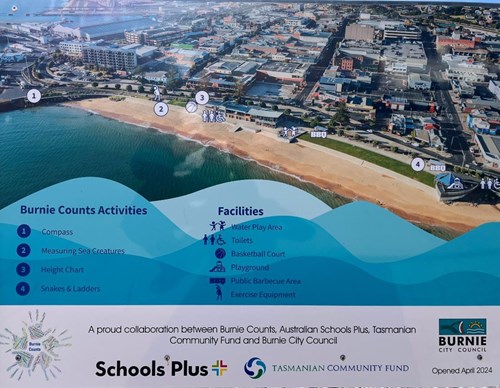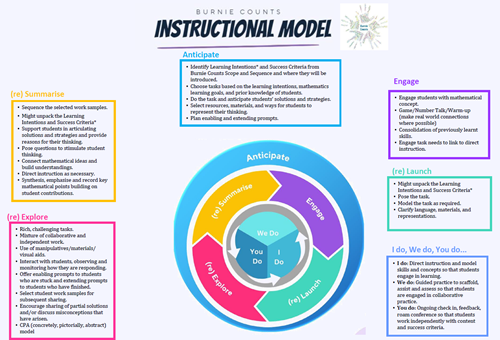Burnie Counts: whole school and system change
Since its inception in February 2022, the Burnie Counts numeracy initiative in north-west Tasmania has proven to be a success story in improving student numeracy outcomes, building the collective efficacy of teachers, and shifting the perception of mathematics in the town’s school communities.
With Year 7 mathematics assessment data indicating that students were entering secondary school with considerable gaps in their knowledge and skills, Burnie High School and four local feeder primary schools had a compelling case for change. They formed the Burnie Counts Collective, with a shared goal to improve numeracy outcomes for students from Years 5 to 8.
While geographically close, Burnie High School, Somerset Primary School, Natone Primary School, Cooee Primary School and Burnie Primary School had traditionally worked largely in isolation from one another.
In February 2022, 28 teachers from the five schools undertook a 3-year improvement project to develop their content knowledge in the mathematics curriculum, develop consistent content, pedagogy and assessment practices, and increase family engagement in numeracy learning. The initial target group of Year 5 through to Year 8 was quickly broadened to a Kindergarten to Year 10 project, to facilitate a whole-school approach.
The project involved three stages over three years: ‘What to teach’, ‘When to teach’ and ‘How to teach’.
What to teach: Big Ideas in Number
In the first year of the collective, teachers were released from classrooms to undertake professional learning on ACARA's revised Australian Curriculum: Mathematics. Professional learning focused on the Big Ideas in Number framework, based on the work of Professor Dianne Siemon (2006). This encompasses the concepts of:
- trust the count
- place value
- additive to multiplicative thinking
- partitioning
- proportional reasoning
- generalising.
When to teach: curriculum mapping and moderation
In the second year of the project, the collective implemented a shared scope and sequence for mathematics and also introduced consistent assessment tasks and practices.
The Burnie Counts Curriculum Map is aligned to the Early Years Number Framework and Australian Curriculum: Mathematics and is mapped to the Big Ideas in Number across each year of schooling, identifying the key non-negotiable markers for when concepts are to be introduced, developed and consolidated, from Kindergarten to Year 10.
The term overviews align across each year of schooling so that students across every year level focus on the same Big Ideas simultaneously, supporting shared student learning and collective teacher professional learning.
The curriculum map identifies the supporting ideas that underpin each of the key ideas and maps the progression of learning. It articulates the assessment to be undertaken each term at each year level, the key mathematical vocabulary developed, and which mental computation strategies need to be taught at each year level.
All staff from the five schools met in the initial weeks of each term to develop a shared rubric for common assessment tasks, identifying observable characteristics for students approaching the standards, those working at the expected standard, those working above the standard and those working well above the standard. Towards the end of term, teachers met again to moderate those assessment tasks against the rubrics.
How to teach: a shared instructional model of teaching
In the third year of the project, the collective implemented a shared evidence-based instructional model of mathematics teaching, providing a consistent lesson structure for mathematics across the schools. Leaders in the cluster developed a model that reflected teacher feedback and evidence-based research, as well as feedback from experts in the field.
The Burnie Counts Instructional Model incorporates two existing models as a starting point: the Gradual Release of Responsibility model (‘I do’, ‘we do’, ‘you do’), which teachers were already familiar and comfortable with, and a structured inquiry model, based on the Peter Sullivan model of structured inquiry, which had been commonly used by teachers in Science and HASS.
The instructional model has six components:
- anticipate
- engage
- launch
- explore
- summarise
- 'I do', 'we do', 'you do'
The model is cyclical and can be entered into at different points within a lesson. Teachers move between the gradual release of responsibility and structured inquiry models, particularly in the ‘explore’ and ‘summarise’ phases, as appropriate.
A shared lesson template was also introduced, outlining:
- curriculum content descriptors
- learning intentions and success criteria
- description of the main task
- prompts for enabling and extending.
Family engagement in numeracy
Given the role of parents as the first educators of their children, parental perception of mathematics can influence students’ own ideas about their capacity to learn maths. As part of the Burnie Counts Collective’s goal to increase family engagement in numeracy learning, parents were provided with access to digital content, including the following.
- Suggestions for parents and carers about ways to support mathematics at home, with supporting information on key maths competencies for each year level, provided through schools’ digital platform, Seesaw.
- The Burnie Counts Facebook page and a website for parents, with information about the Big Ideas and helpful hints on how parents can support their child at home, including maths games and challenges.
The collective also held Parent Showcases to help raise the profile of maths in each school. Parents and carers were invited to their child’s school to engage in a range of games and activities that not only showcased the maths learning that the students had undertaken but also promoted maths as fun and engaging and aimed to build a positive mindset towards maths within families. Students were further empowered through their role in the design process for the showcases, and also through having a role in teaching the games and activities to their family members, providing them with an opportunity to share their mathematical understanding and build their maths confidence.
Supporting transition to secondary school
As part of their transition process, Burnie High School hosted a Year 6 Maths Relay, with students from each of the four feeder primary schools in attendance. Student participated in a range of maths activities and challenges, ensuring they could have fun with maths, meet other students, and generally feel more comfortable and prepared for their transition to secondary school the following year.
Burnie Counts in the community
Through a partnership with Burnie Council and Tasmanian Community Fund, the Burnie Counts project also extended into the wider community, with the creation of the Burnie Counts Foreshore Activities and Maths Trail on the Burnie Foreshore.

Trail map example provided by © Josh Salter.

Image used with permission from © Wendy Edwards.
Impact
Over the three years of the project, the Burnie Counts Collective achieved an increase in the percentage of students achieving medium-to-high growth from Year 7 to Year 9, from 77% of students in 2021, to 87% and 89% in 2023 and 2024 respectively. The 2024 results surpassed achievement at similar schools (73%) and the state average (75%).
The percentage of Year 9 students within the collective who achieved strong growth in numeracy also increased from 59% in 2023 to 64.2% in 2024. These results surpassed similar schools (achievement of 50%) and the state average (54%).
Teachers, students and parents from across the five schools were surveyed at the start of the project in February 2022 and then annually each November for three years.
Student surveys demonstrated a shift in the level of student confidence and enjoyment of mathematics. The extent to which students enjoy learning maths, feel confident in doing well at maths and look forward to maths lessons increased, particularly after the first year of the project.
Similarly, there was a notable shift in the perception of mathematics among parents. When responding to being asked what their first feeling is when they think about mathematics, the number of parents who selected ‘fear’ halved between 2022 and 2023 and continued to decline in 2024. Over the course of the project, there was a steady increase in the percentage of parents who indicated they ‘like’ maths and a decrease in the percentage of parents who indicated that they ‘don’t care’ about maths. Given the impact that family attitudes towards mathematics can have on students’ own perception of themselves as mathematics students, this is testament to the work of the collective in promoting and reinforcing key maths concepts and effective practices through family engagement initiatives.
The survey data indicated an increase in teacher efficacy over the three years. The extent to which teachers feel confident in teaching mathematical concepts and responding to questions from their students about mathematics increased notably. Surveys also indicated that teachers had become more confident in using a variety of assessment strategies.
It is apparent from the data that through developing content knowledge, and consistent content, pedagogy and assessment practices through a shared whole-school approach, the Burnie Counts Collective have improved student learning outcomes, improved teacher confidence and lifted the profile and perception of mathematics across the school communities.
Sustaining change
The Burnie Counts journey does not end there. To embed and sustain change, the Burnie Counts Collective will continue to engage in moderation and further embed the instructional model. Videos are being developed and linked to the instructional model and shared with new staff to ensure the continuation of a consistent whole-school approach.
Beyond the Burnie Counts Collective, the project is being expanded to become ‘Tassie Counts’, commencing with six new school clusters in 2025, with a playbook and further suite of instructional videos in development.
Our thanks to Josh Salter, Assistant Principal at Burnie High School and Project Leader of the Burnie Counts project, for his time and generosity in sharing the story of the project. Josh received a Teaching Fellowship at the 2024 Commonwealth Bank National Teaching Awards for his innovative leadership with the project. The Teaching Fellowship includes $25,000 to fund a strategic school project, as well as a 12-month professional development program, including coaching and engagement with leading education experts to help further develop skills, networks and capabilities.
Find out more: Burnie City Council.
